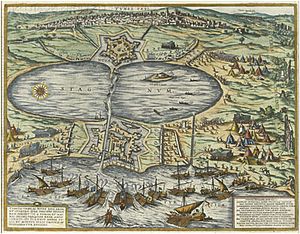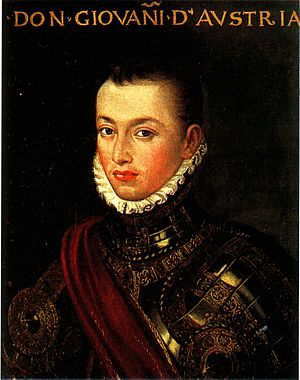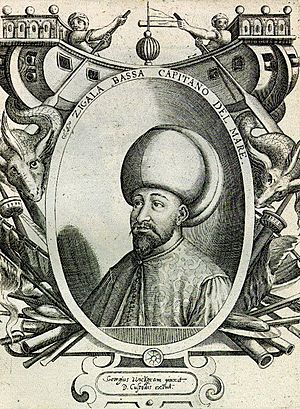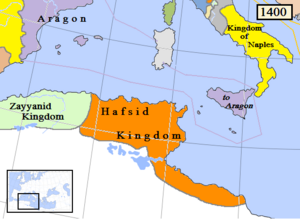Conquest of Tunis (1574) facts for kids
Quick facts for kids Conquest of Tunis |
|||||||||
|---|---|---|---|---|---|---|---|---|---|
| Part of the Ottoman-Habsburg wars | |||||||||
 The Ottoman fleet attacking Tunis at La Goulette in 1574. |
|||||||||
|
|||||||||
| Belligerents | |||||||||
| Commanders and leaders | |||||||||
| Strength | |||||||||
| Total men: 7,000 | 250–300 warships Total men: 100,000 |
||||||||
| Casualties and losses | |||||||||
| 6,700 killed, 300 prisoners | 25,000 (Spanish claim) |
||||||||
The conquest of Tunis in 1574 was a big battle where the Ottoman Empire took control of the city of Tunis. The Spanish Empire had captured Tunis just a year before. This event was very important. It showed that the Ottoman Empire was the strongest power in North Africa. This victory helped the Ottomans control a large area, including Algiers, Tunis, and Tripoli. These places then became known for their corsair (pirate) activities.
Contents
A City in Conflict: Tunis's History

Tunis was a city that many powerful groups wanted to control. It was first taken by the Ottomans in 1534. Their leader was a famous admiral named Hayreddin Barbarossa.
However, the very next year, a powerful European ruler, Charles V, led a large army and captured Tunis for Spain. He left a Spanish army there and put a local ruler, Lhacène, in charge. Lhacène was from the Hafsid dynasty.
Years later, in 1569, Uluj Ali, the Ottoman leader of Algiers, took Tunis back for the Ottoman Empire. But after a big Christian victory at the Battle of Lepanto in 1571, John of Austria (a Spanish commander) managed to capture Tunis again in October 1573.
The Ottomans Take Tunis
In 1574, some European leaders wanted to weaken Spain. William of Orange from the Netherlands and Charles IX of France (through his ambassador) asked the Ottoman ruler, Selim II, for help. They wanted him to attack Spain from a different direction.
Selim II agreed to help. He sent a message to the Dutch and also tried to connect them with rebellious groups in Spain and pirates in Algiers. Most importantly, Selim II sent a huge fleet to attack Tunis in the autumn of 1574. This helped reduce the pressure Spain was putting on the Dutch.
The Battle of La Goleta

Selim II gathered a massive fleet for the battle at La Goleta. It had between 250 and 300 warships and about 75,000 soldiers. The Ottoman fleet was led by two important commanders: Sinan Pacha and Alūj Ali.
Troops from Algiers, Tripoli, and Tunis also joined the Ottoman forces. This made their total strength around 100,000 men. They attacked both Tunis and a strong fort called La Goleta. The fort of La Goleta was defended by 7,000 Spanish soldiers, but it fell on August 24, 1574. The last Christian soldiers in a small fort near Tunis gave up on September 13, 1574.
John of Austria tried to send ships from Naples and Sicily to help the city, but bad storms stopped him. Spain was also very busy fighting in the Netherlands and did not have enough money to send much help.
A famous writer named Miguel de Cervantes, who later wrote Don Quixote, was a soldier during these events. He was with John of Austria's troops trying to save Tunis. He said that the Ottomans attacked the fort of Tunis 22 times. He claimed the Ottomans lost 25,000 men, and only 300 Christian soldiers survived.
Abd al-Malik, who would later become the King of Morocco, also fought on the Ottoman side during this conquest.
Gabrio Serbelloni was the commander of the fort of Tunis. The general of La Goleta, Don Pedro Portocarerro, was captured and died on his way to Constantinople. Many of the captured soldiers were forced to work on Ottoman ships.
This battle was the final step in the Ottoman Empire taking full control of Tunis. It ended the rule of the Hafsid dynasty and removed the Spanish presence from the city.
What Happened Next
The Ottoman victory in Tunis, led by Occhiali, helped the Dutch by making Spain less able to fight them. This even led to peace talks at a meeting called the Conference of Breda.
However, after Charles IX died in May 1574, the connections between the Ottomans and the Dutch became weaker. Even so, the Ottomans are thought to have supported a Dutch revolt in 1575–1576. In 1582, they even opened a special office for trade in Antwerp.
Eventually, the Ottomans made a truce (a peace agreement) with Spain. They then turned their attention to a war with Persia (the Ottoman–Safavid War (1578–1590)). The Spanish government also ran out of money and went bankrupt on September 1, 1575.
After this truce, fighting between the Ottomans and Spain started again in 1591. However, these later conflicts were not as big or important as the earlier ones.
See also
 In Spanish: Conquista de Túnez (1574) para niños
In Spanish: Conquista de Túnez (1574) para niños
- Siege of Castelnuovo
- Islam and Protestantism
- Franco-Ottoman alliance



